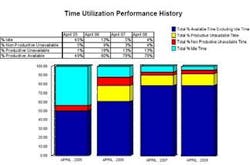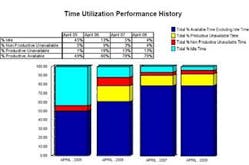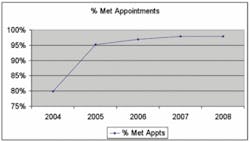by Robert Croker, Charles Leonardo
American Water, an investor-owned water/wastewater utility in Vorhees, NJ, provides drinking water, wastewater and other related services to approximately 15.6 million people in 32 states in the U.S., as well as Ontario, Canada. Because of its broad geographic expanse, American Water has multiple field operation centers spread across its service area.
In order to adopt best operating practices and take full advantage of economies of scale, American Water decided to standardize field service practices across its mobile workforce. The utility achieved this standardization with its "Service First" mobile workforce management program. As part of the Service First initiative, American Water deployed more than 1,000 Panasonic Toughbook mobile PCs throughout its field personnel and implemented Service Suite from Ventyx to optimize the dispatch and scheduling of these mobile employees.
To date, the Service First strategy has been a resounding success. It has changed the workday for the utility's field service representatives and supervisors, improving met appointments, time utilization, completed orders, and other key performance indicators.
Dispatching Best Practices to the Field
One of the cardinal rules for successfully integrating acquired companies is to establish best practices and ensure they are implemented across the enterprise. All too often, however, this rule is sometimes overlooked for a critical link in the customer service chain: mobile workers who serve customers in the field. And, as most utilities know, any breakdown in this "last mile" can mean the difference between satisfied customers and angry calls to the utility call center.
Standardizing best practices is an exercise that American Water knows well. The utility has successfully integrated multiple large acquisitions in the last ten years. As part of that process, it was important that acquired companies took advantage of technological advances that could help them better integrate mobile workforce management solutions, like the Service First program. It helped American Water take disparate operational field practices of acquired companies and migrate them to a standardized mobile workforce.
Service First was created to meet these challenges by providing highly responsive customer service where everyone works with the most current information to ensure that each job is completed by the right person at the right time. The utility had several goals in mind for the program, namely to:
- Improve customer satisfaction with quicker response to emergencies, more met appointments and near real-time updates of customer account information;
- Better understand workforce activities, enabling the measurement of travel times and "wrench times" for specific activities and orders completed per day;
- Better manage workforce activities, enabling field personnel to work more orders during the available time
- Increase workforce productivity by providing the ability to benchmark between work units to evaluate efficiency and the effects of local conditions;
- Properly resource field activities by having factual data to improve decision-making, such as understanding when workload increases exceed existing resources;
- Standardize work practices so that all field workforces are using the same process, doing work in much the same way.
Phased Implementation
American Water assembled a core group of personnel to develop scope, process and requirements for the initiative, as well as review product offerings, develop a project plan, conduct detailed planning and develop a human resource strategy. Employees from both business and IT fields were involved: business personnel were involved in developing and implementing communications and training; IT personnel developed architecture and hardware requirements, as well as plans to link the utilities' customer information systems with Service Suite. Both groups were heavily involved in the selection of equipment, considering other work management systems in the implementation and performing standard due diligence, including discussion with other end users.
The rollout of the Service First program was done by region, beginning with the northeast states in June 2004 and followed by the southeast in October 2004, the central states in January 2005 and the western states in July 2005.
This phased rollout provided both benefits and challenges. For instance, it allowed a representative from the subsequent regions to participate in the rollout of the previous region. This approach allowed for those representatives to serve as business leads and develop and train peers during their local region's rollout. At the same time, it meant that regions rolling out later had less involvement in decision making. And, it created continuity challenges as the core implementation team's composition changed. There were also challenges associated with trying to implement enterprisewide standardization while managing four different rollouts with four sets of implementation activities, each with their own specific requirements.
In the end, however, the implementation was a success. The hardware and software is easy to use and was accepted by over 1,000 field service representatives (FSRs) who now operate in a wireless environment. Even the new reporting activities were accepted by end users, as they were allowed to design the reporting. To help mitigate concerns in the field and improve communication, the implementation team created field resource coordination centers (FRCCs), which act as buffers between the call center and the field.
A New Way of Providing and Measuring Service
The Service First program proved to be highly successful. It enabled American Water to achieve its goals by replacing paper-based, manual processes with standardized automated processes that improve communication, productivity and efficiency.
Before Service First, dispatchers printed paper service orders, manually sorted them, and dispatched them by hand to individual FSRs. With Service First, service orders are wirelessly dispatched to technicians' laptops in the field, eliminating the time wasted by managing paper service orders and requiring FSRs to report to a central office to receive their paper orders at the beginning of each day. As a result, emergency and time-critical service orders are handled more efficiently because they can be dispatched to the most appropriate technician based on current location as well as skill set.
The Service First system also improved American Water's ability to monitor and manage its field workforce activities. With the paper-based system, information on FSRs' status and availability was limited, and their individual productivity was difficult to measure. Furthermore, key performance indicators (KPIs) such as met appointments were not recorded, making goal-setting and improvement very challenging. With Service First, FSR status is monitored continually and in real time. Other KPIs, such as travel time, job completion time, productivity and idle time, are automatically generated by Service Suite and reported back to the utility.
The improved measurement and reporting of FSR activity also helps supervisors work more efficiently. Instead of spending time dealing with time-critical orders, the supervisors can spend more time in the field helping FSRs improve their productivity. And, empowered with greater knowledge of FSR activities, supervisors can reschedule orders to minimize overtime — increasing efficiency and saving the utility unnecessary expenses.
Real Change Brings Noticeable Improvements
With productivity reports now generated regularly by the Service First system, American Water is able to identify marked improvements in such areas as appointments met, emergency response, total orders completed and time utilization. In one region, for example, American Water has reported a dramatic improvement in time utilization. Idle time has decreased from 45 percent of the day in April 2005 to 4 percent in April 2008. In this same time period, productive available time increased from 49 percent to 79 percent (see Fig. 1).
In another region, orders worked per hour per FSR has nearly tripled from approximately 1.5 in August 2005 to 4.5 in April 2008. And, across the board, met appointments increased from 80 percent in 2004 to well over 95 percent in 2008 (see Fig. 2).
The improvements have been recognized and appreciated by both FSRs and supervisors.
Dan Farabee, FSR with Pennsylvania American Water, is pleased with the improvement in customer service: "The response time to customer emergencies is the most noticeable improvement to field customer service operations. We can respond now in a flash.'"
Pennsylvania American Water Network Supervisor Dave Ward is glad to see the paper-based work order distribution system replaced: "Before Service First, I spent hours sorting hundreds of orders. I would handle each pile of orders multiple times, sorting water and sewer orders by location and by appointment time. Now that it's automated, I have more time to coach technicians in the field."
A specialist in the northeast FRCC in Belle Mead, NJ, Leigh Perez has a bird's eye view of how Service First is enhancing delivery of field customer service. "Before Service First, miscommunication was a problem. Now, we are able to mitigate concerns that an FSR may have about a particular order. And, likewise, we can address questions from the call center about the status of an order."
Perez added, "The FRCC is working together better now with field operations. Over time we have learned the service areas and have identified towns that should be grouped together for a given coverage area. That has proven to be one of the major improvements we've made to accommodate the field." By regrouping towns into new sub-areas, it makes a given FSR's coverage area more logical and helps shorten travel times between orders.
Karen Cooper, manager of business services at the customer service center in Alton, IL, said, "The speed of our response to customers is significantly improved. Now, with real-time technology in place, we have information about completed orders almost instantaneously, enabling the Customer Service Center to provide accurate and timely information to relay to customers about the status of their order. It's an enormous leap forward and it enables us to be far more customer-focused."
Lessons Learned
As successful as the Service First implementation has been, any rollout provides important lessons, which can help you or your peers in future projects. The lessons we learned during this rollout include:
- Ensure strong executive management support.
- Include early and consistent involvement by appropriate geographic and functional groups.
- Clearly establish roles.
- Maintain constant and regular communication.
- Work to get acceptance of process, procedures, roles and activities.
- Ensure early HR involvement and bargaining unit acceptance.
- Maintain project continuity by avoiding project team turnover.
- Recruit a full-time core team.
- Plan for refresher training after implementation.
- Clearly define benefits.
- Standardize project management activities: scope, planning, post-project support.
- Plan for training and handoff of post-project activities.
Follow these lessons, and you are likely to have as productive a rollout as American Water had with Service First.
About the Authors:
Robert Croker is Manager, Best Operating Practices, for American Water's Alton Customer Service Center.
Charles Leonardo is the Mobile Technical Lead for American Water. He oversees overall support for the Advantex Workforce Management System, and supports and oversees the network infrastructure, field devices, security, fleet vehicles, GPS, GIS and surrounding processes for more than 1,200 field service reps. He has worked in the mobile space for the past 10 years and has designed and implemented many mobile solutions to enhance business productivity and operational efficiencies.





